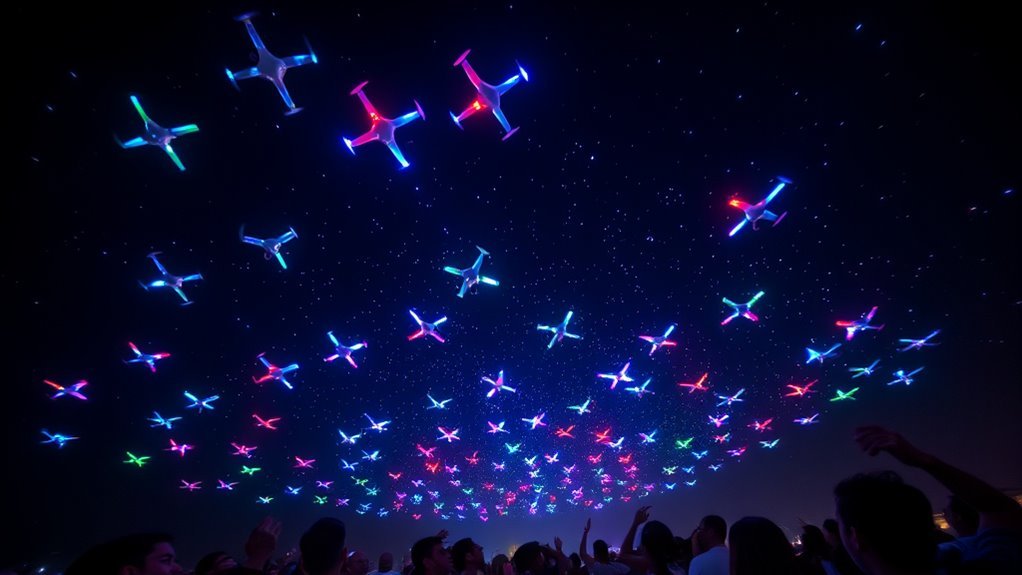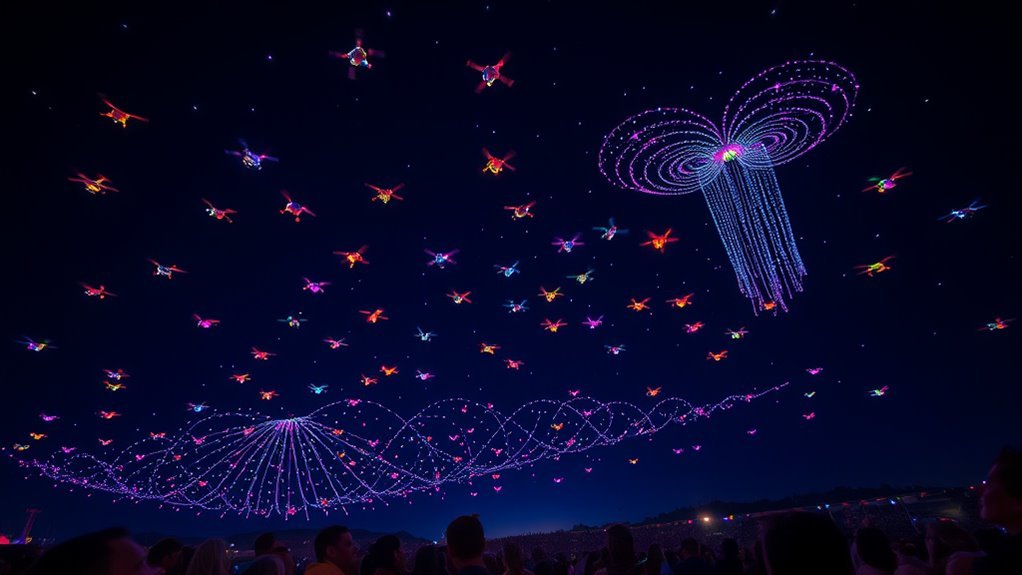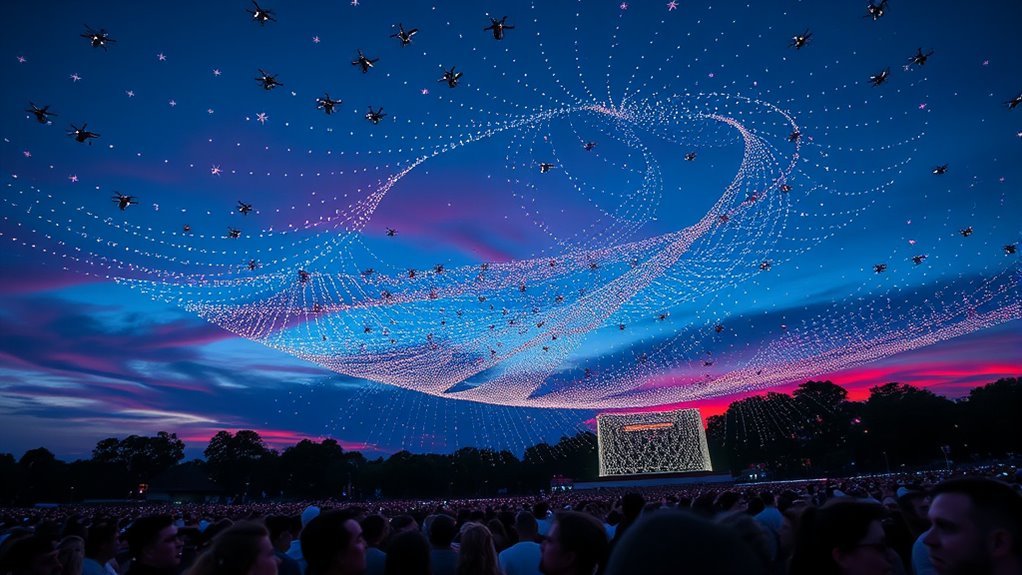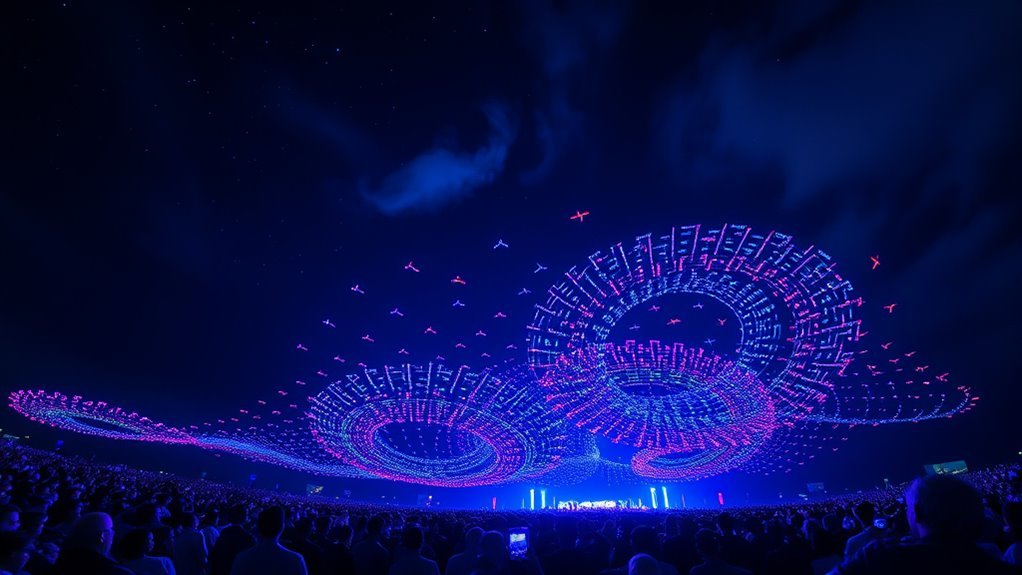Drone shows are mesmerizing displays where synchronized drones create dynamic light formations, often set to music. These spectacular performances involve advanced technology for real-time communication and precise choreography. Planning begins with a defined theme, mapping flight paths, and obtaining necessary permits. Safety is essential, with inspections and contingency plans in place. Arriving early enhances your experience and allows you to find the best viewing spots. Explore more to uncover the fascinating world behind these aerial spectacles.
What Are Drone Shows?

Drone shows are enchanting displays of coordinated flying unmanned aerial vehicles that create stunning aerial performances, often synchronized to music or thematic narratives. You’ll find various drone types participating in these shows, including quadcopters and fixed-wing drones, each offering unique capabilities. The performance styles can range from intricate formations to dynamic light displays, showcasing not only technological prowess but also artistic expression. As seen during Disney Springs drone show events, you might witness choreographed routines that tell a story, engaging audiences with their visual splendor. As drone shows continue to evolve, they push the boundaries of creativity and innovation, providing an exhilarating experience that reflects the desire for freedom and exploration in the skies. Additionally, companies like SkyMagic Drone Light Shows are known for their innovative technology and precise choreography, enhancing the overall experience of these spectacular displays. Whether at festivals or special events, these shows are unforgettable spectacles.
The Technology Behind Drone Shows

While the artistry of drone shows captivates audiences, it’s the underlying technology that makes these performances possible. Central to this magic is effective drone communication, enabling each unit to relay its position and status in real-time. Advanced algorithms facilitate flight synchronization, ensuring that hundreds of drones move in perfect harmony. The Intel Shooting Star system exemplifies this precision with its ability to deploy up to 1,000 drones simultaneously.
Here’s a quick overview of the key components:
| Component | Function | Importance |
|---|---|---|
| Drone Communication | Real-time data exchange | Keeps drones coordinated |
| Flight Synchronization | Algorithmic control | Creates stunning visuals |
| Software Control | Programming drone behavior | Enables complex choreographies |
Understanding these elements helps you appreciate the intricate balance of technology and creativity that defines drone shows, granting freedom to the imagination. The ability to utilize collision avoidance systems ensures safety while enhancing the visual spectacle.
How Drone Shows Are Planned

Planning a drone show involves a meticulous blend of creativity and technical expertise, building on the sophisticated technology that allows for seamless execution. You’ll need to focus on drone logistics and event coordination to guarantee everything runs smoothly. Start by defining the show’s theme and visual elements, which will guide your design process. Additionally, understanding the synchronization precision of the drones will greatly enhance the coordination of flight paths. Next, coordinate with local authorities for permits and safety regulations, as compliance is vital. After that, you can map out the flight paths and timings, ensuring each drone operates in harmony with the others. Finally, conduct test flights to identify potential issues and fine-tune the performance. With careful planning and attention to detail, your drone show can deliver an exhilarating experience that captivates your audience. Additionally, ensuring precise timing during the synchronization of movements is crucial for a successful performance.
The Role of Choreography in Drone Shows
Choreography plays an essential role in transforming a drone show from a simple display into a mesmerizing spectacle. By employing various choreography techniques, you can create an enthralling experience that tells a story through the movement of drones. Here are three key elements to take into account:
- Synchronization: Aligning drone movements with music or thematic elements enhances the emotional impact. The Intel Shooting Star 2 offers millisecond synchronization, making it an ideal choice for precise choreography.
- Formation Changes: Using dynamic formations helps maintain visual interest and keeps the audience engaged.
- Color and Light: Integrating vibrant colors and innovative lighting effects amplifies the visual storytelling, making your show memorable.
When you master these techniques, you’ll not only entertain but also inspire your audience, providing a sense of freedom and awe that only a well-choreographed drone show can deliver. Furthermore, the use of synchronized choreography allows for precise alignment and breathtaking visuals that captivate viewers.
Safety Measures and Regulations
Before you launch an engaging drone show, it’s vital to understand the safety measures and regulations that govern these aerial displays. Guaranteeing drone safety isn’t just smart; it’s required. You’ll need to comply with local regulations, which often include obtaining permits and adhering to altitude limits. Familiarize yourself with no-fly zones, as flying in restricted areas can lead to hefty fines or worse. Regularly inspect your drones to make sure they’re in top condition—this reduces the risk of accidents during your performance. Additionally, having a contingency plan for emergencies is significant. By prioritizing safety and regulations compliance, you not only protect your audience and crew but also enhance the overall experience of your mesmerizing drone show.
The Future of Drone Shows
The future of drone shows is set to revolutionize the entertainment industry, merging technology with artistry in unprecedented ways. As you look ahead, you’ll notice some exciting future trends shaping this enthralling medium:
The future of drone shows promises to blend technology and artistry, transforming entertainment in groundbreaking ways.
- Increased interactivity, allowing audiences to influence performances in real-time.
- Advanced AI integration, enabling drones to create complex choreographies autonomously, similar to the way drones achieve collision tolerance in obstacle-laden environments.
- Eco-friendly innovations, minimizing environmental impact while still delivering stunning visuals.
- Current performances often showcase over a thousand drones, enhancing the complexity and vibrancy of displays.
These developments promise to enhance audience engagement, making each show a unique experience. Imagine being part of a performance where your input directly influences the outcome! With the combination of cutting-edge technology and creative expression, drone shows are poised to redefine how we experience entertainment, offering a sense of freedom and connection like never before.
Tips for Enjoying Your First Drone Show
To make the most of your first drone show, it’s essential to arrive early to secure a good seat. This gives you time to find the best viewing location, ensuring you won’t miss any of the stunning aerial displays. A little planning can enhance your experience and make it truly memorable.
Arrive Early for Seating
Arriving early for seating can greatly enhance your experience at a drone show, as it allows you to secure a prime spot with an unobstructed view. By getting to the venue ahead of time, you can soak in the atmosphere and prepare for the spectacle. Here are a few tips to maximize your early arrival:
- Scout the area: Familiarize yourself with the layout, including entrances and exits.
- Find good company: Arrive with friends or family to share the excitement and engage in lively discussions.
- Capture the moment: Use your early time to take photos or videos of the setup and the crowd.
Choose Optimal Viewing Location
Wondering where to position yourself for the best view at a drone show? First, consider the ideal viewing angles. Ideally, you want to be at least 300 feet away from the launch site for an unobstructed experience. Look for a spot that offers a clear line of sight, avoiding trees or buildings that could block your view.
Also, pay attention to crowd dynamics; large groups can shift unexpectedly, impacting your sightline. Finding a less crowded area can enhance your enjoyment, allowing you to focus on the stunning choreography of the drones. Arriving early helps you scout the perfect location, ensuring you soak in every light display without distractions. With the right spot, you’re set for a memorable experience!
Frequently Asked Questions
How Much Does It Cost to Organize a Drone Show?
Organizing a drone show involves a detailed budget breakdown, typically ranging from $15,000 to $100,000. You’ll need to take into account show logistics, including permits, equipment, and staffing, to guarantee a successful, enchanting experience.
Can Drones Be Used for Events Other Than Shows?
Absolutely, drones have versatile applications beyond shows. They can enhance events like weddings or corporate gatherings through aerial photography, live streaming, and light displays, providing a unique experience that captivates attendees and elevates the occasion.
What Types of Drones Are Used in Shows?
When it comes to shows, you’ll find drones with specific specifications tailored for precision and agility. These drones execute intricate show choreography, creating stunning visual displays that captivate audiences and showcase technological advancements in aerial entertainment.
How Long Do Drone Shows Typically Last?
Imagine a mesmerizing dance in the sky; drone show duration typically ranges from 10 to 30 minutes. The typical show length allows for enchanting displays while keeping audiences engaged, ensuring a thrilling experience from start to finish.
Are Drone Shows Environmentally Friendly?
Drone shows can be environmentally friendly, but it depends on the technology used. While drone emissions are lower than traditional fireworks, their ecological impact varies. You’ll want to evaluate both benefits and drawbacks when appraising sustainability.

